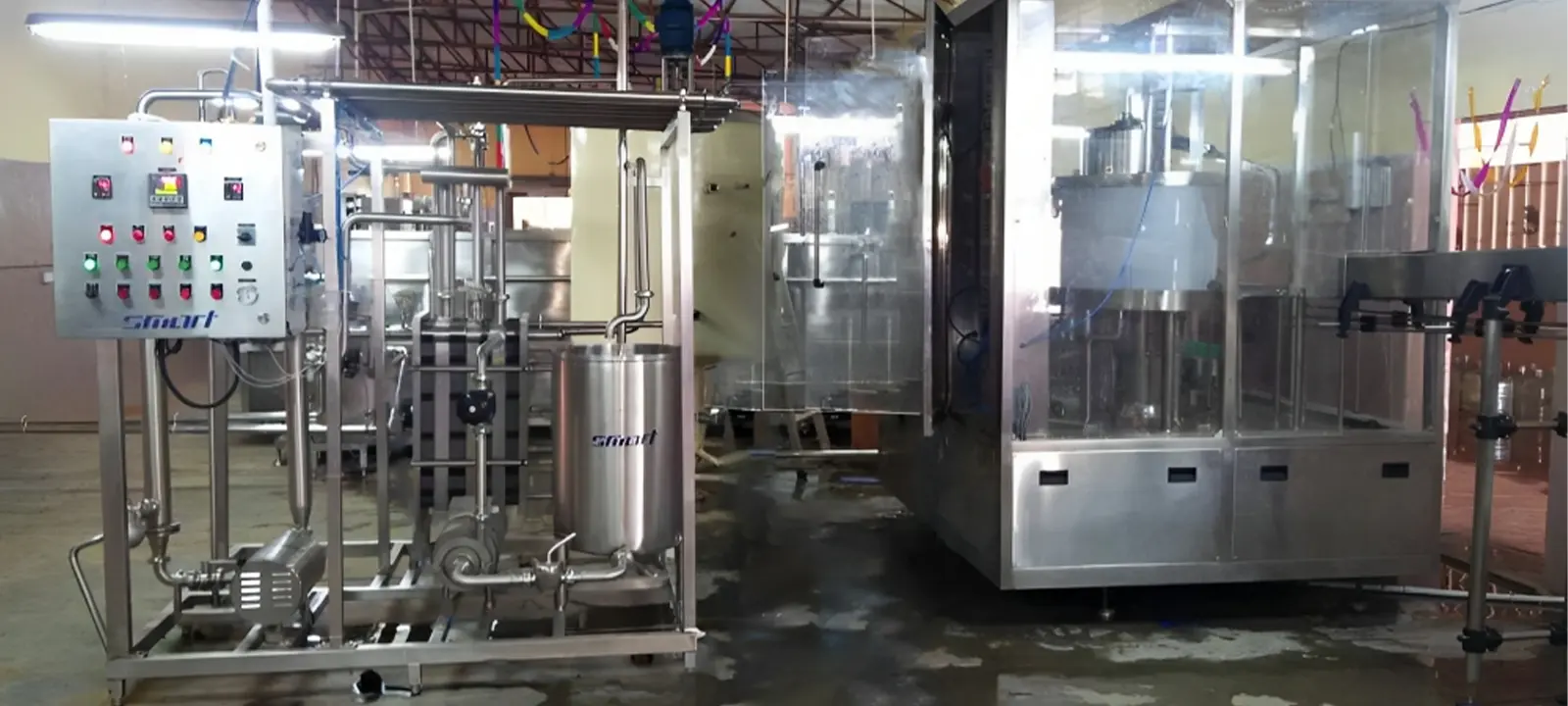JUICE PROCESSING UNIT
A Juice Processing Unit is a specialized facility dedicated to the transformation of fresh fruits into flavourful and nutritious juices. Key steps include washing, sorting, extraction, filtration, pasteurization, and optional blending for unique Flavors. Quality control is maintained throughout the process to ensure the safety and taste of the final product. Packaged juices are then distributed to retailers, providing consumers with a convenient and diverse range of refreshing beverage options.
JUICE PROCESSING UNIT

Fruit Juice:
Fruit juice is a popular beverage extracted from fruits through crushing or pressing. Common varieties include Mango, orange, apple, grape, and pineapple juice. While enjoyed for their refreshing taste and nutritional benefits, consumers should be mindful of added sugars in commercial products.
Fruit Juice Processing :
Fruit juice processing involves several steps to transform raw fruits into the final juice product. Here is a simplified overview of the typical process
- Harvesting and Sorting: Fruits are harvested at their peak ripeness. Sorting is done to remove damaged or spoiled fruits.
- Cleaning and Washing: Fruits are thoroughly cleaned to remove dirt, pesticides, and other impurities.
- Extraction: Depending on the fruit type, extraction methods can include pressing, crushing, or centrifugation to separate the pulp from the fruit.
- Filtration: The extracted juice may undergo filtration to remove any remaining solids or impurities.
- Concentration: Some juices are concentrated to reduce volume and facilitate transportation. Later, water is added back before packaging.
- Additives: Some commercial juices may include additives such as sweeteners, preservatives, or flavor enhancers. It's essential to check labels for these ingredients.
- Blending: Different batches of juice may be blended to achieve consistent taste, color, and texture.
- Homogenization: Fruit homogenization is a key step in fruit juice processing to break down particles and fat globules. This mechanical process ensures a uniform texture, prevents separation of components, and enhances the stability of the juice. It is widely applied in the production of various fruit juices to achieve a consistent and quality product.
- Pasteurization: Juice is often pasteurized to kill bacteria, yeast, or molds that could spoil the product. This step also extends the shelf life of the juice.
- Packaging: The final product is packaged in bottles, cartons, or other containers. Packaging may involve sterile conditions to maintain product quality.
- Distribution: Packaged and quality-checked juice is distributed to retailers and consumers.
Fruit Juice Processing solutions:
At We Smart Engineering, we take pride in our global leadership role, providing cutting-edge and high-quality Juice Processing equipment that caters to the dynamic requirements of the beverage industry. Our unwavering commitment to excellence has positioned us as a trusted partner for Juice Processing ventures worldwide.
Here are some key pieces of equipment used in fruit juice processing:
- Fruit Washer
- Removes dirt, debris, and impurities from the fruits before processing.
- Fruit Sorter/Grader
- Sorts fruits based on size and quality, ensuring uniformity in the processing line.
- Fruit Pulper
- Crushes or presses the fruits to extract the juice.
- Juice Filters
- Removes solids and pulp from the juice to achieve a clear and smooth liquid. This can include screens, filters, or centrifuges.
- Pasteurizers
- Heats the juice to a specific temperature for a set duration to kill bacteria and enzymes, extending the shelf life of the product. Common pasteurization methods include heat exchangers and flash pasteurization.
- Juice Homogenizers
- Concentrates the juice by removing water, increasing the sugar content and viscosity. This is commonly used in the production of concentrated fruit juices.
- Aseptic Filling Machine
- Fills and seals the juice in a sterile environment, ensuring a longer shelf life without the need for refrigeration. Aseptic filling is crucial for preserving the quality of the juice.
- Clean-in-Place (CIP)
- Ensures the sanitation of processing equipment by providing automated cleaning solutions, maintaining hygiene standards.
As your trusted partner, We Smart Engineering is committed to propelling juice processing units to new heights of success with our cutting-edge equipment and turnkey solutions. With a focus on innovation and reliability, we lead the way in fostering excellence in juice processing operations globally.